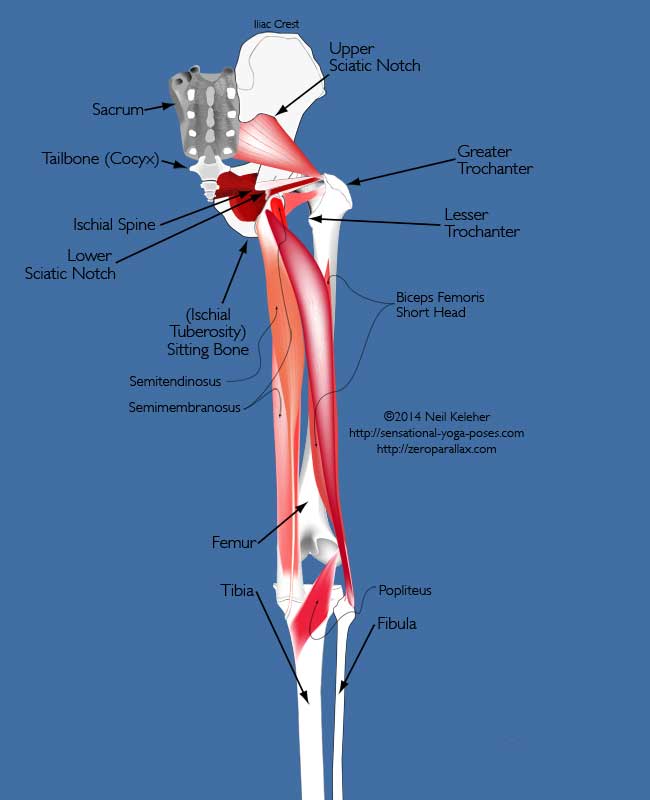Hamstring problems
Understanding how the hamstrings work so that you can work towards fixing problems
I teach a lot of different muscle control techniques in my classes. And I've been lucky enough to have some very difficult cases (including myself) which has led me to come up with some simple exercises for activating various muscles. The hamstrings can be a challenge.
Where the quads are more or less a single joint muscle (except for the rectus femoris) the hamstrings are a multi-joint muscle. They work on the back of the knee and the hip. And that can make activating them tricky.
Hamstring attachment points
At the upper end the hamstrings attach to the sitting bone, the bony protuberance you can feel when you sit on a hard surface. At the lower end the hamstrings diverge to attach to the outside and inside of the lower leg bones.
The knee can rotate and the hamstrings can help control this rotation
An important idea to understand is that when the knee is bent, the lower leg bones can rotate relative to the thigh bone.
Since the hamstrings attach to both the inner and outer edges of the lower leg bones, the hamstrings can be used to help control this rotation.
On the other hand, if the shin bones are stabilized against rotation, particularly while standing, then this gives the hamstrings a firm foundation from which to activate.
If this stability is lacking this may be one reason for your hamstrings are failing to fire or why you are having difficulty activating them.
The inner and outer hamstrings can work against each other
At the knee joint the hamstrings are opposed by the quadriceps.
If the quadriceps are activate, the hamstrings can work against the quads. If both the inner and outer hamstrings are functional, they can work against each other to help stabilize the lower leg bones against rotation.
So one or the other of the inner or outer hamstring isn't functioning, this can result in the opposite hamstring also not being able to fire.
Shin rotators that oppose the hamstrings
As mentioned, at the upper end the hamstrings attach to the sitting bone. This is a corner point of the hip bone, a major point of leverage.
There are three other corner points, the ASIC (the front point of the hip crest), the PSIC (the rear point of the hip crest, near where it attaches to the sacrum) and the pubic synthesis (pubic bone).
To anchor the hamstrings at the upper end you can create a downward pull on the ASIC or the pubic synthesis.
Muscles that attach to these points include the tensor fascia latae, the sartorius, the gracilis. And these all attach to the inner and outer edges of the lower leg bone. So here again, rotational stability of the lower leg bone may be helpful in getting the hamstrings to activate.
With the shins stabile, the muscles that oppose the hamstrings can activate, making it easier for the hamstring themselves to activate since muscles need an opposing force to work against. If that force isn't generated by movement or isn't apparent externally, then you need to generate it internally via opposing muscle activation.
Another reason why activating the quads makes it easier for the hamstrings to activate
Note that the previously mentioned muscles run over the vastus muscles and the vastus muscles, when active can push out against these muscles giving them operating length. So in some cases you may find that activation the quads makes it easier to activate your hamstrings.
Hip muscles that oppose the hamstrings
The gluteus minimus and iliacus can also be used to create a downwards pull on the ASICs. And so activation of these can affect your ability to activate your hamstrings.
Adding tension to the sacrotuberous ligament to anchor the hamstrings
At their upper end, the connective tissue of the hamstrings ties in to the sacrotuberous ligament which generally runs from the ischial tuberosity (sitting bone) to the sacrum. The gluteus maximus also has attachments to this ligament (as does the piriformis.) If you activate those fibers of the gluteus maximus, you can thus add tension to the sacrotuberous ligament and that in turn may make it easier to activate your hamstrings.
Why calf activation may help hamstring activation
At the lower end the hamstring tendons partially cross the tendons of the gastrocnemius muscle. When this muscle activates, it effectively tightens or adds tension to the bottom tendons of the hamstrings, anchoring them, and so calf activation may be another prerequisite, in some cases, to activating your hamstrings.
Learning how to activate your hamstrings, calves and glutes
For some simple exercises for activating calves, the hamstring tendons, the hamstrings themselves and the glutes check out the hamstring muscle control course. It's not a long course. It includes the simple exercises I use to teach my students how to activate their hamstrings. It includes exercises for activating your glutes also.
Published: 2020 03 24



